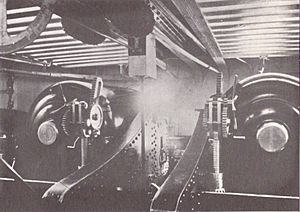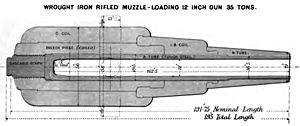RML 12-inch 35-ton gun facts for kids
Quick facts for kids Ordnance RML 12-inch 35-ton gun |
|
|---|---|

An interior view of one of the two main battery turrets aboard the British battleship HMS Devastation, showing a rear view of the turret's two 12-inch (305 mm) 35-ton rifled muzzle-loaders. These guns were replaced in 1891 by 10-inch (254 mm) breech-loading rifles.
|
|
| Type | Naval gun |
| Service history | |
| In service | 1873–1909 |
| Used by | Royal Navy |
| Production history | |
| Designed | 1871 |
| Manufacturer | Royal Arsenal |
| Unit cost | £2,154 |
| No. built | 15 |
| Specifications | |
| Mass | 35 long tons (36,000 kg) |
| Barrel length | 162.5 inches (4.13 m) (bore + chamber) |
|
|
|
| Shell | 706 pounds 12 ounces (320.6 kg) (Palliser) 613 pounds (278.1 kg) (Common & Shrapnel) |
| Calibre | 12-inch (304.8 mm) |
| Muzzle velocity | 1,390 feet per second (420 m/s) |
The RML 12-inch 35-ton gun was a very big cannon used on British warships in the 1870s. These powerful guns were the main weapons on battleships. They were a type of 'rifled muzzle-loading' gun. This means they had grooves inside the barrel to make the shell spin. They were also loaded from the front.
Contents
How the Gun Was Designed
This gun was first designed in 1871. It was meant to be an 11.6-inch gun. It would fire a shell weighing about 700 pounds (318 kg).
However, the first tests were not very good. So, the gun's barrel was made wider. It became a 12-inch (305 mm) gun. This new version fired a slightly heavier shell. It weighed about 706 pounds (320.5 kg).
Where These Guns Were Used
These large guns were mainly put on British battleships. They were a very important part of the Royal Navy's power.
On Devastation-class Battleships
The 12-inch 35-ton guns were installed on the Devastation-class battleship class of battleships. These ships were launched starting in 1873. They were some of the most advanced warships of their time.
The Thunderer's Special Guns
The battleship HMS Thunderer also used 12-inch guns. However, the two guns in its front turret were a bit different. They were actually 12.5-inch (318 mm) 38-ton guns. These bigger guns were specially made to fire 12-inch shells. This was because the regular 12-inch 35-ton guns were not ready.
Using these special guns helped simplify ammunition. Both the front and back turrets could use the same shells. Sadly, one of these special 12-inch 38-ton guns exploded. This happened on January 2, 1879. It was accidentally loaded twice.
Ammunition Used by the Gun
The 12-inch 35-ton gun could fire different types of shells. These shells changed over time to become better.
Studded Shells
When the gun first came out, its shells had "studs." These were small bumps on the side of the shell. The studs fit into the grooves inside the gun's barrel. This made the shell spin as it left the gun. Spinning helped the shell fly straight and hit its target.
After 1878, a new part called an "attached gas-check" was added to these studded shells. This part helped reduce wear on the gun. It also made the shells fly farther and more accurately.
Studless Shells
Later, an even better design called "automatic gas-checks" was created. These new gas-checks could make the shell spin all by themselves. This meant that shells no longer needed studs.
So, the gun could use both old studded shells and new studless shells. This made the ammunition supply more flexible.
Types of Shells
The main type of shell was the 706-pound (320.5 kg) "Palliser" shell. This was an armor-piercing shell. It was designed to break through enemy ship armor. For maximum power, it was fired with a "battering charge" of 110 pounds (50 kg) of gunpowder.
Other shells included "Shrapnel" and "common" (exploding) shells. These weighed 613 pounds (278 kg). They were fired with a smaller amount of gunpowder.
See also
- List of naval guns


